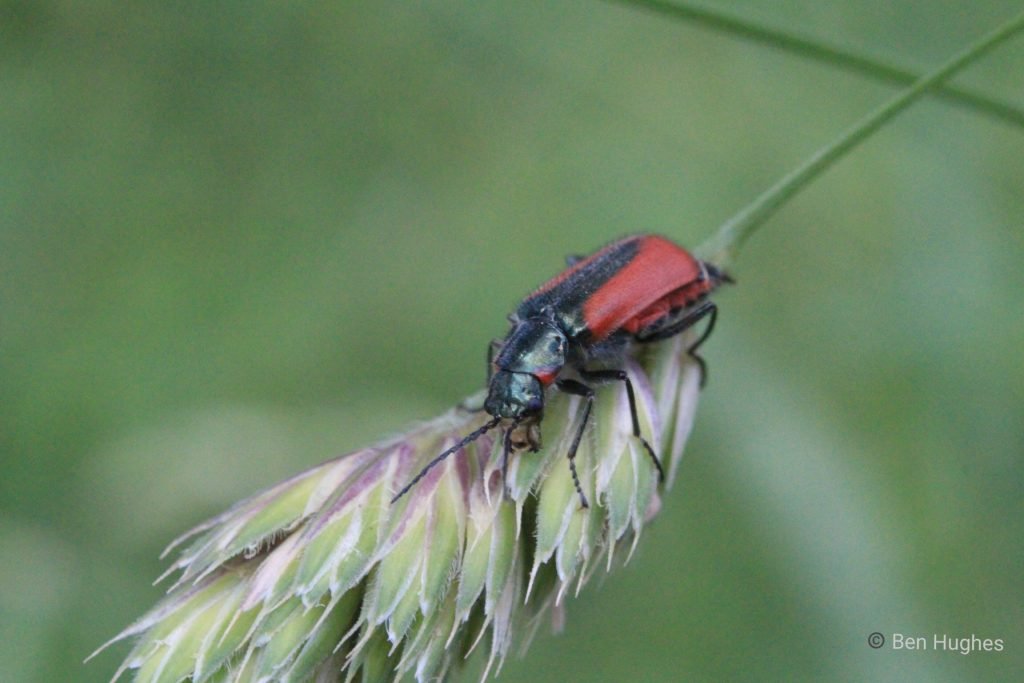Bumbling on towards saving the Scarlet Malachite Beetle
Or… How can a T-shirt with a bee picture on it help save a rare beetle?
Our Bumblebee T-shirt depicts possibly our most iconic pollinator and one of the World’s best loved insects. As such it is an ambassador for many lesser known and often un-loved pollinators. Our T-shirts are made with the intention to get people talking about nature and, in this case, insects and pollen.

Conservation
The profits from this particular design will go into conservation work for an almost unknown pollinator. The scarlet malachite beetle (Malachius aeneus) which we have been working to conserve since 1999. Your purchase will actually be saving a beetle.
One of Britain’s rarest insects, this pollen loving beetle is now known from just four sites in the UK. Only two of these sites have strong populations. We’ve looked into its life-cycle and found that thatched buildings are important. It lays its eggs in the thatch, the larval (grub) stage remains there. But they must be close to flower rich meadows with particular grasses and a favourable mowing regime. We’ve designed and produced miniature nursery cottages with thatched roofs. (You can read more here.) It was only through examining these that we were able to prove the beetles breed in thatch. In theory the cottages can be placed in meadows, preferably in managed reserves, and support introduced populations of beetles.

We would like to put the bee T-shirt funds into this work. We have decided to introduce another step and to use the sales to fund a modest scarlet malachite beetle book. The book will provide information and raise awareness about this beautiful little being. Also other pollinators and plants which share its habitat. The book and its profits will help save the beetle.
Bumblebee Celebrity
It may seem odd using a bee to save a beetle but it is like bringing in a celebrity for a little known cause. There is almost certainly a connection between bees and scarlet malachite beetles. Other members of the family Malachidae are associated with solitary wasp and bee nests. It’s quite possible that the scarlet malachite beetle larvae prey on the larvae of solitary bees. All breeding in thatch and similar habitats that provide the right environment undisturbed and untreated by chemicals. There has been a known decline in bee numbers and bee species. Over 50 are prioritised and 17 in rapid decline (Falk, 2015.) This, along with other factors could have put the scarlet malachite beetle in peril across its European range.
Talking about nature
Much of what is going on in nature is under-studied, complex and difficult to understand. We believe that by taking snippets of what we do know or that we are interested in and turning it into an entertaining format, a story, for young and old alike, more people of all ages can get more of a grip on nature conservation, wildlife gardening and talking about nature.
I work in many fields but am not an expert in any of them. I attend meetings where competent naturalists clam up for fear of exposing their lack of knowledge. We all lack knowledge or competence in something and nobody can know the thousands of British animals or plants. I tend to intensively study single species and know very little about the others. But when I broaden my research I find that it is often relevant to the one I am looking at. I’m not sure I can do it the other way round, pick a family and narrow down and my target would be a threatened species in need of help anyway. For many of these there is not time or resources to become an overall expert. We must just find out what we can.
Frederick Sladen
In 1892 a 16 year old boy called Frederick Sladen self-published his life’s-work. A small hand written book called The Humble Bee. He did it simply by following bees, digging up colonies and re-establishing them near his home. He read what little he could find. Bumblebees were understudied at the time and his book, a classic, had a major impact. Many invertebrates are still understudied and many of these are endangered. We believe nature needs to be talked about more and wildlife feared less. We need more naturalists to help us know and understand the community of beings who populate the countryside, gardens and other habitats around us.
Our modest and child-like study into scarlet malachite beetles began at a time when the beetle’s future looked quite hopeless. We had a hunch but no sure way of fathoming its life cycle. Once we cracked the life cycle through quite childish innovation (if it can be called that) hope flooded in. We now feel sure we can save the beetle. Funding ceased in 2014 but we have managed to keep it up and we think T-shirt and print sales can help bring this beetle back.
Thank you for helping to save this beautiful beetle.
References
Field Guide to the Bees of Great Britain and Ireland, Steven Falk, British Wildlife Field Guides, Bloomsbury, 2015.


